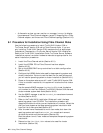• Wwidmgr User’s Manual
6.2 Fibre Channel Overview
Fibre Channel supports multiple protocols over the same physical interface.
Fibre Channel is primarily a protocol-independent transport medium;
therefore, it is independent of the function that it is used for.
The TruCluster Server uses the Fibre Channel Protocol (FCP) for SCSI to
use Fibre Channel as the physical interface.
Fibre Channel, with its serial transmission method overcomes the
limitations of parallel SCSI by providing:
• Data rates of 100 MB/sec, 200 MB/sec, and 400 MB/sec
• Support for multiple protocols
• Better scalability
• Improved reliability, serviceability, and availability
Fibre Channel uses an extremely high-transmit clock frequency to achieve
the high data rate. Using optical fibre transmission lines allows the
high-frequency information to be sent up to 40 km, the maximum distance
between transmitter and receiver. Copper transmission lines may be used
for shorter distances.
6.2.1 Basic Fibre Channel Terminology
The following list describes the basic Fibre Channel terminology:
Frame
All data is transferred in a packet of information
called a frame. A frame is limited to 2112 bytes. If
the information consists of more than 2112 bytes, it
is divided up into multiple frames.
Node
The source and destination of a frame. A node
may be a computer system, a redundant array of
independent disks (RAID) array controller, or a disk
device. Each node has a 64-bit unique node name
(worldwide name) that is built into the node when it
is manufactured.
N_Port Each node must have at least one Fibre Channel
port from which to send or receive data. This node
port is called an N_Port. Each port is assigned a
64-bit unique port name (worldwide name) when it
6–4 Using Fibre Channel Storage


















